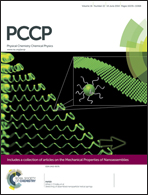Clusters in the adsorbates of vapours and gases: Zeta isotherm approach
Abstract
A procedure for determining the structure of vapour and gas adsorbates that is based on the Zeta adsorption isotherm is reported. For vapours and for gases, this isotherm supposes that an adsorbate consists of particle clusters with the number of particles in a cluster denoted ζ, where ζ can be 1, 2, 3… up to a maximum of ζm, and predicts the isotherm constants are independent of pressure. For vapours, this allows the isotherm constants to be determined from isotherm measurements made at pressures less than the saturation-vapour pressure, Ps, but applied at pressures greater than Ps. Since ζ has an upper limit, we show that there are no singularities in the vapour or gas adsorption isotherms for any pressure. This allows the adsorption of vapours at pressures greater than Ps to be investigated: clusters with ζm molecules are predicted to increase in number as PV is increased, until they form an adsorbed film with each adsorption site occupied by a ζm-cluster. We apply the same procedure to determine the value of ζm for gas adsorption. For CO adsorbing on Ni(100), ζm is predicted to be unity for all the cases considered, indicating that the adsorbate consists of adsorbed molecules without any clustering. For H2 adsorption on the three different materials, ζm is found to be two: indicating the adsorbate consists of both adsorbed molecules and atoms. For each material considered, a pressure is predicted where the mole fractions of both are equal, and at higher pressure, the mole fraction of adsorbed molecules exceeds that of the adsorbed atoms.


 Please wait while we load your content...
Please wait while we load your content...